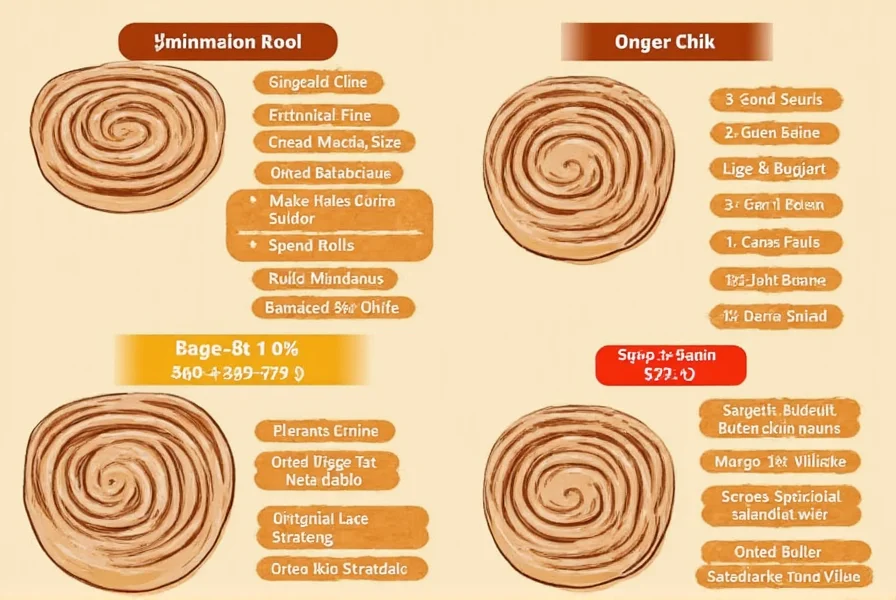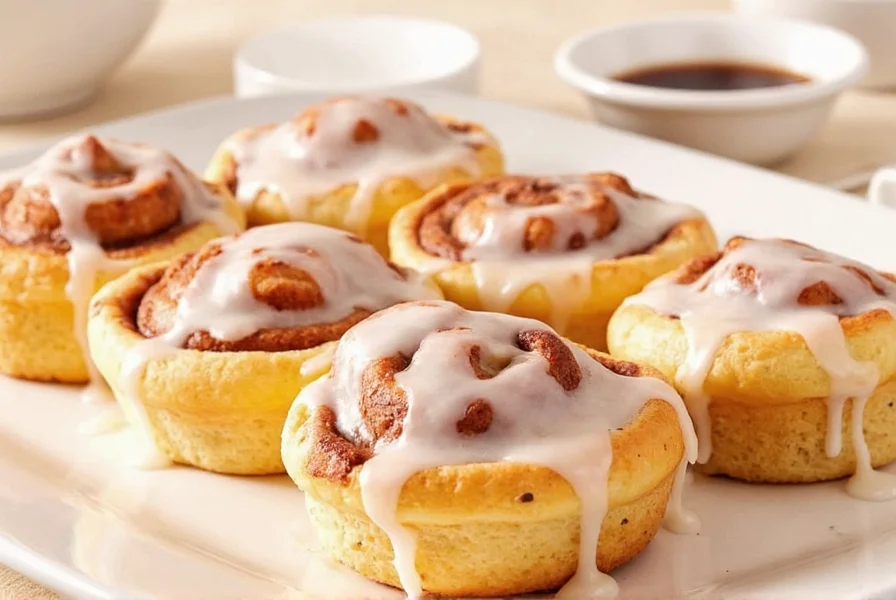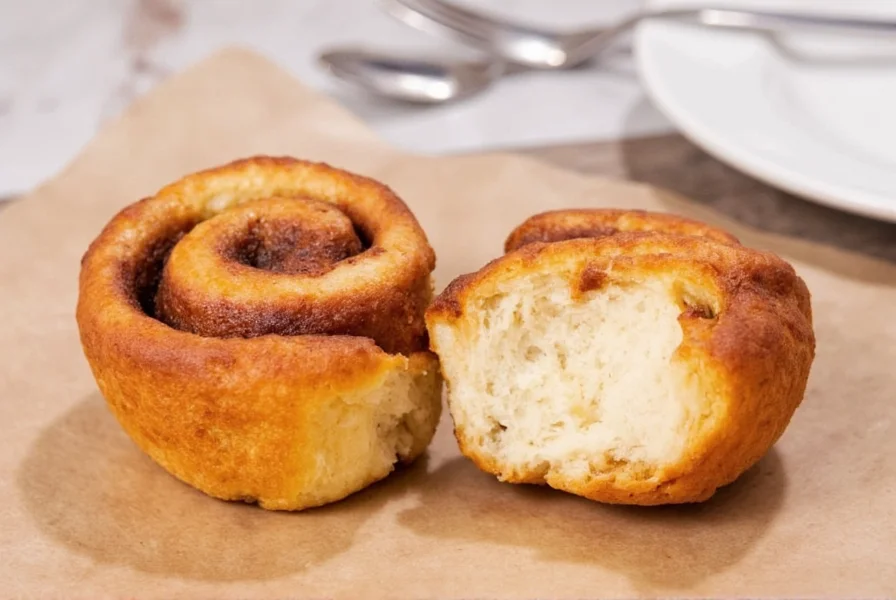Understanding the caloric content of cinnamon rolls helps make informed dietary choices without completely eliminating this beloved treat from your menu. Whether you're tracking macros, managing weight, or simply curious about nutrition facts, knowing what's in your favorite pastry matters.
Calorie Breakdown by Cinnamon Roll Type
Cinnamon rolls aren't one-size-fits-all when it comes to nutrition. The calorie count depends heavily on preparation method, ingredients, and serving size. Let's examine the differences between common varieties.
| Type of Cinnamon Roll | Approximate Calories | Key Contributing Factors |
|---|---|---|
| Homemade (standard recipe, 3.5 oz) | 250-350 | Butter, sugar, flour, yeast dough |
| Store-bought refrigerated roll | 200-270 | Preservatives, smaller size, less icing |
| Bakery-style (with icing) | 350-500 | Extra butter, sugar, generous icing |
| Cinnabon Classic Roll | 880 | Large portion, high-fat ingredients, cream cheese icing |
| Mini cinnamon roll (1.5 oz) | 120-180 | Reduced portion size |
What Contributes to Cinnamon Roll Calories
The calorie density in cinnamon rolls comes primarily from three components: carbohydrates, fats, and sugars. A typical 3.5-ounce homemade roll breaks down as follows:
- Carbohydrates: 40-50g (mainly from flour and sugar)
- Fats: 10-15g (from butter in dough and icing)
- Sugars: 20-30g (cinnamon-sugar filling and icing)
- Protein: 4-6g (from flour)
The icing alone can add 50-150 calories depending on the amount and recipe. Cream cheese icing contains more fat but slightly less sugar than traditional powdered sugar glazes.
Factors That Change Calorie Counts
Several variables affect the final calorie count of your cinnamon roll:
Portion Size Matters Most
A roll that's twice as large isn't just double the calories—it often contains exponentially more due to additional filling and icing. Restaurant portions frequently contain 2-3 times the calories of a standard homemade roll.
Ingredient Substitutions
Using alternatives can significantly reduce calories without sacrificing flavor:
- Replacing some butter with unsweetened applesauce cuts fat content
- Using Greek yogurt instead of cream cheese in icing reduces calories by 30-40%
- Reducing sugar by 25% in filling often goes unnoticed
Preparation Method
Baking technique affects final calorie density. Rolls baked in a pan with space between them develop a crustier exterior with slightly less moisture (and marginally fewer calories) than rolls baked touching each other, which create a softer, more calorie-dense product.

Health Considerations and Enjoying in Moderation
Cinnamon rolls fit into a balanced diet when enjoyed mindfully. Rather than viewing them as "off-limits," consider these practical approaches:
- Pair with protein: Enjoy your roll with Greek yogurt or a protein shake to slow sugar absorption
- Split servings: Bakery portions often contain 2-3 servings—split with a friend
- Timing matters: Consume after physical activity when your body can better utilize the carbohydrates
- Make it count: Choose quality over quantity—savor one excellent roll rather than several mediocre ones
Lower-Calorie Alternatives Worth Trying
You don't need to eliminate cinnamon rolls entirely to manage calorie intake. Consider these modifications that maintain flavor while reducing calories:
- Whole wheat option: Substitute half the all-purpose flour with whole wheat for added fiber (reduces net carbs)
- Light icing: Use a dusting of powdered sugar instead of heavy frosting (saves 80-120 calories)
- Mini portions: Bake in muffin tins for controlled 150-200 calorie servings
- Healthy swaps: Try "cinnamon roll" oats or protein mug cakes for 100-150 calorie alternatives

Making Informed Choices
When purchasing store-bought cinnamon rolls, check nutrition labels for serving size confusion. Many packages contain multiple servings despite appearing as a single item. A "single roll" on the package might actually represent 2-3 individual pastries.
At bakeries, don't hesitate to ask about ingredients and portion sizes. Some establishments offer "light" versions or can prepare rolls with less icing upon request. Understanding cinnamon roll nutrition facts empowers you to enjoy treats while staying aligned with your health goals.
Frequently Asked Questions
How many calories are in a cinnamon roll without icing?
A standard homemade cinnamon roll without icing contains approximately 200-280 calories. The icing typically adds 50-120 calories depending on the amount and type used. Removing the icing can reduce the total calorie count by 20-30% for most recipes.
Are store-bought cinnamon rolls higher in calories than homemade?
Not necessarily—it depends on the specific product. Some store-bought rolls use lower-quality ingredients that might contain more sugar and fats, while others are formulated to be smaller portions. A typical refrigerated tube roll (like Pillsbury) has about 220 calories, which is often lower than a homemade version. However, bakery-style store rolls frequently contain significantly more calories than homemade versions due to larger portions and richer ingredients.
How can I reduce calories in homemade cinnamon rolls without sacrificing taste?
You can reduce calories in homemade cinnamon rolls by: using 75% of the recommended sugar in filling, substituting half the butter with unsweetened applesauce, making smaller portions (mini rolls), and using Greek yogurt instead of cream cheese in icing. These modifications can reduce total calories by 25-40% while maintaining most of the flavor profile that makes cinnamon rolls enjoyable.
Do cinnamon rolls have any nutritional benefits beyond calories?
While primarily a treat food, cinnamon rolls do provide some nutritional elements. The flour offers carbohydrates for energy, and the cinnamon contains antioxidants. Some recipes with eggs provide small amounts of protein. When made with whole wheat flour, they can contribute dietary fiber. However, these benefits don't outweigh the high sugar and fat content, so they should be considered occasional treats rather than nutritional staples.











 浙公网安备
33010002000092号
浙公网安备
33010002000092号 浙B2-20120091-4
浙B2-20120091-4